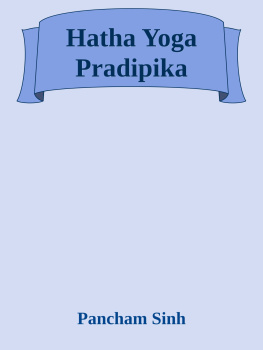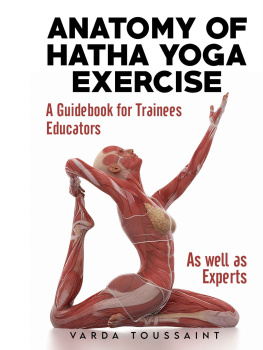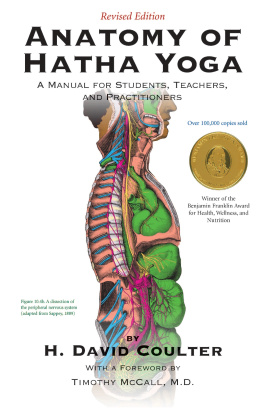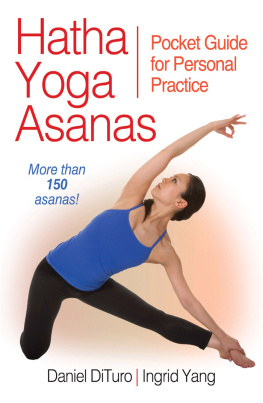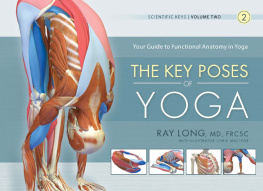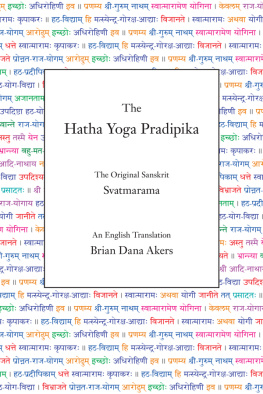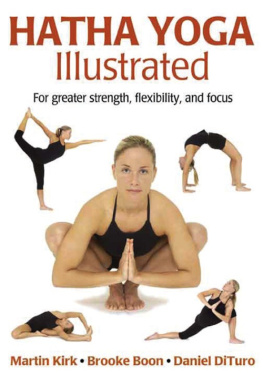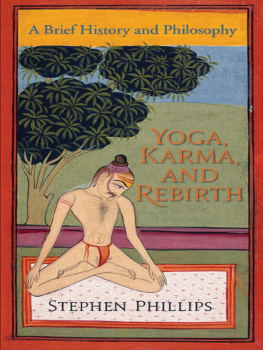Pancham Sinh (tr.) - Hatha Yoga Pradipika
Here you can read online Pancham Sinh (tr.) - Hatha Yoga Pradipika full text of the book (entire story) in english for free. Download pdf and epub, get meaning, cover and reviews about this ebook. genre: Romance novel. Description of the work, (preface) as well as reviews are available. Best literature library LitArk.com created for fans of good reading and offers a wide selection of genres:
Romance novel
Science fiction
Adventure
Detective
Science
History
Home and family
Prose
Art
Politics
Computer
Non-fiction
Religion
Business
Children
Humor
Choose a favorite category and find really read worthwhile books. Enjoy immersion in the world of imagination, feel the emotions of the characters or learn something new for yourself, make an fascinating discovery.
- Book:Hatha Yoga Pradipika
- Author:
- Genre:
- Rating:4 / 5
- Favourites:Add to favourites
- Your mark:
- 80
- 1
- 2
- 3
- 4
- 5
Hatha Yoga Pradipika: summary, description and annotation
We offer to read an annotation, description, summary or preface (depends on what the author of the book "Hatha Yoga Pradipika" wrote himself). If you haven't found the necessary information about the book — write in the comments, we will try to find it.
Hatha Yoga Pradipika — read online for free the complete book (whole text) full work
Below is the text of the book, divided by pages. System saving the place of the last page read, allows you to conveniently read the book "Hatha Yoga Pradipika" online for free, without having to search again every time where you left off. Put a bookmark, and you can go to the page where you finished reading at any time.
Font size:
Interval:
Bookmark:
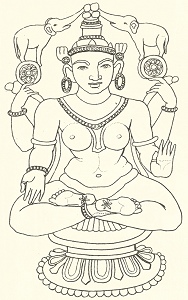 From The Hindu Pantheon, by Edward Moor [1810] (Public Domain Image) |
Hatha Yoga Pradipika tr. by Pancham Sinh [1914] |
Possibly the oldest extant text about Hatha Yoga,The Hatha Yoga Pradipikawas written about the 15th century CE, by Swami Swatmarama, a disciple ofSwami Goraknath.
PRODUCTION NOTES: This edition incorporates the text ofthe 1914 Pancham Sinh translation and Devanagari and romanizationof the Sanskrit text.The Sanskrit was derived from an ITRANS file from the Internet.The versification does not match up precisely with the Sanskrittext in the book, particularly in Chapter III.Therefore, I've attempted to match up the ITRANS verses withthe verses in the book based on my limited reading knowledge of Sanskrit.This embedded ITRANS converter is still experimental: this bookwas essentially a pilot project for the feature.I welcome feedback about errors in the conversion of the ITRANS Sanskrit textto Unicode.
Note that the Firefox browser has long-standing and still uncorrected problemsdisplaying Unicode Devanagari, e.g. 'i' is displayed after the consonant,instead of preceding it.This is a known problem with Firefox and there is nothing we can do about it.--JBHTitle PageTable of ContentsIntroductionChapter 1. On AsanasChapter II. On PranayamaChapter III. On MudrasChapter IV. On Samadhi.
Scanned at sacred-texts.com, May 2007. Proofed and formatted by John Bruno Hare, August 2007. This text is in the public domain in the United States because it was published prior to January 1st, 1923. These files may be used for any purpose.
Previous
PAGES. | |||
Introduction | |||
Chapter | I | on | Asanas |
II | Pranayama | ||
III | Mudras | ||
IV | Samadhi |
There exists at present a good deal of misconception with regard to the practices of the Hatha Yoga. People easily believe in the stories told by those who themselves heard them second hand, and no attempt is made to find out the truth by a direct reference to any good treatise. It is generally believed that the six practices, ( ) in Hatha Yoga are compulsory on the student and that besides being dirty, they are fraught with danger to the practiser. This is not true, for these practices are necessary only in the existence of impurities in the Nadis, and not otherwise.
) in Hatha Yoga are compulsory on the student and that besides being dirty, they are fraught with danger to the practiser. This is not true, for these practices are necessary only in the existence of impurities in the Nadis, and not otherwise.
There is the same amount of misunderstanding with regard to the Pranayama. People put their faith implicitly in the stories told them about the dangers attending the practice, without ever taking the trouble of ascertaining the fact themselves. We have been inspiring and expiring air from our birth, and will continue to do so till death; and this is done without the help of any teacher. Pranayama is nothing but a properly regulated form of the otherwise irregular and hurried flow of air, without using much force or undue restraint; and if this is accomplished by patiently keeping the flow slow and steady, there can be no danger. It is the impatience for the Siddhis which cause undue pressure on the organs and thereby causes pains in the ears, the eyes, the chest, etc. If the three bandhas ( ) be carefully performed while practising the Pranayama, there is no possibility of any danger.
) be carefully performed while practising the Pranayama, there is no possibility of any danger.
There are two classes of students of Yoga: (1) those who study it theoretically; (2) those who combine the theory with practice.
Yoga is of very little use, if studied theoretically. It was never meant for such a study. In its practical form, however, the path of the student is beset with difficulties. The books on Yoga give instructions so far as it is possible to express the methods in words, but all persons, not being careful enough to follow these instructions to the very letter, fail in their object. Such persons require a teacher versed in the practice of Yoga. It is easy to find a teacher who will explain the language of the books, but this is far from being satisfactory. For instance, a Pandit without any knowledge of the science of Materia Medica will explain  as
as  or an enemy of thorns, i.e., shoes, while it is in reality the name of a medicinal plant,
or an enemy of thorns, i.e., shoes, while it is in reality the name of a medicinal plant,
The importance of a practical Yogi as a guide to a student of Yoga cannot be overestimated; and without such a teacher it is next to impossible for him to achieve anything. The methods followed by the founders of the system and followed ever afterwards by their followers, have been wisely and advisedly kept secret; and this is not without a deep meaning. Looking to the gravity of the subject and the practices which have a very close relation with the vital organs of the human body, it is of paramount importance that the instructions should be received by students of ordinary capacity, through a practical teacher only, in order to avoid any possibility of mistake in practice. Speaking broadly, all men are not equally fitted to receive the instructions on equal terms. Man inherits on birth his mental and physical capitals, according to his actions in past births, and has to increase them by manipulation, but there are, even among such, different grades. Hence, one cannot become a Yogi in one incarnation, as says Sri Kisna  and again
and again 
There are men who, impelled by the force of their actions of previous births, go headlong and accomplish their liberation in a single attempt; but others have to earn it in their successive births. If the student belongs to one of such souls and being earnest, desires from his heart to get rid of the pains of birth and death, he will find the means too. It is well-known that a true Yogi is above temptations and so to think that he keeps his knowledge secret for selling it to the highest bidder is simply absurd. Yoga is meant for the good of all creatures, and a true Yogi is always desirous of benefitting as many men as possible. But he is not to throw away this precious treasure indiscriminately. He carefully chooses its recipients, and when he finds a true and earnest student, who will not trifle with this knowledge, he never hesitates in placing his valuable treasure at the disposal of the man. What is essential in him is that he should have a real thirst for such knowledgea thirst which will make him restless till satisfied; the thirst that will make him blind to the world and its enjoyments. He should be, in short, fired with 
Font size:
Interval:
Bookmark:
Similar books «Hatha Yoga Pradipika»
Look at similar books to Hatha Yoga Pradipika. We have selected literature similar in name and meaning in the hope of providing readers with more options to find new, interesting, not yet read works.
Discussion, reviews of the book Hatha Yoga Pradipika and just readers' own opinions. Leave your comments, write what you think about the work, its meaning or the main characters. Specify what exactly you liked and what you didn't like, and why you think so.

